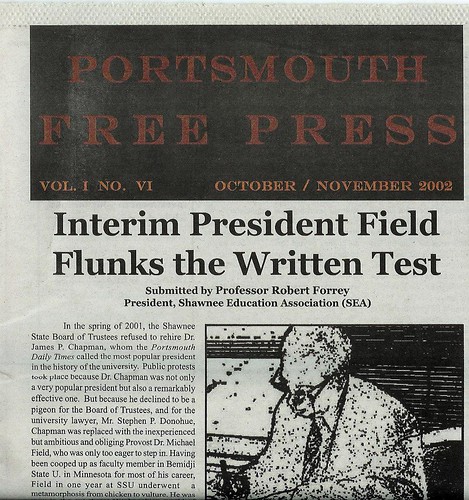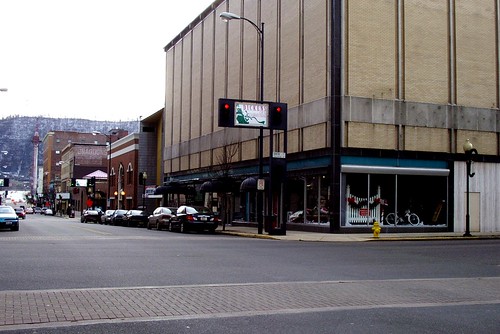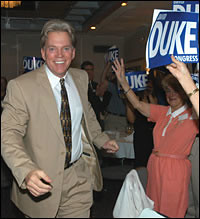
Andrew O. Clausing, circa 1980
Andrew O. Clausing (1922-2002) was a controversial political figure in Portsmouth, but on the basis of research I have done, I believe he was an honest man who was mauled by the Portsmouth media and the monied class back in 1980. But unlike Harold Daub, the subject of my previous blog, Clausing did not live to see his vindication. He did live long enough, however, to see that the huge corporate computers by which he had once made his living as a programmer and about which he had mixed feelings, become small and cheap enough to be, literally, in the hands of ordinary people, who have created a revolution in communications. Although he passed away as recently as 2002, Clausing probably could not have imagined that just three years later he would be resurrected in online newspapers and forums, and in blogs (short for weblogs), which reach thousands of readers through cyberspace in the rapidly evolving phenomenon called the internet. (See my archived 29 July 2004 blog, “Digital Revolution.”)
If you controlled the Portsmouth media back in 1980, you could control the minds, emotions, and perceptions of many people, as the demonizing of Clausing, Daub, and Mark Price that took place illustrates. Back then the Portsmouth Daily Times and the radio stations WPAY and WNXT could get people to believe almost anything, such as the lie that Clausing, Daub, and Price were anti-Semitic and anti-Catholic. In a WPAY editorial (broadcast 3 February 1980), the general manager Tom Reeder asked whether Clausing, Daub, and Price “HAVE THE GUTS TO GIVE THE REASON [WHY THEY FIRED CITY MANAGER BARRY FELDMAN], WILL THEY OPENLY SAY THEY ARE AGAINST JEWS AND CATHOLICS?” Not only were they accused of being against Jews and Catholics, they were also accused of being enemies of all the residents of Portsmouth, where they supposedly pursued their goal of ruining the city.
The media campaign against the three councilmen was so effective that Clausing found people he had known all his life believing what they were reading in the newspaper and hearing on the radio about him. He was even compared to Hitler. Twenty-five years later there are still people on the Hill who believe he was a petty dictator. Having been a young Marine who fought in the South Pacific in the Second World War, Clausing knew what it was like to be under attack by the enemies of freedom, but he hardly could have anticipated being attacked as an enemy of the people whose freedom he had once risked his life defending. But would Vietnam veteran and triple amputee Max Cleland have ever thought he would lose his congressional seat because he would be accused of being unpatriotic?
As an example of the kind of media attacks against Clausing I am referring to, days before the election in 1980 in which Clausing would be recalled from office, a vitriolic editorial in the
Portsmouth Daily Times (31 Oct. 1980) claimed that “the government of Portsmouth practically has been held hostage” by three councilmen whose malicious willfulness threatened the “survival of the city itself.” The councilmen were not only against the mall, the editorial claimed, they were threatening the city itself, a charge as vague as it was preposterous. The editorial was unsigned but may have been written by Don Smith, the editor, or possibly Paul Penix, the publisher. But whoever wrote the editorial may have consulted a thesaurus for additional terms of abuse to heap upon the three councilmen. The editorial called the actions of Clausing, Daub, and Price illegal, hateful, shameful, disgraceful, and contemptible. The editorial called on voters “to end this reign of arrogance, cowardice, incompetence and neglect.”

Clausing criticizing publisher Penix in
Daily Times, Jan. 23, 1980
If you accept the editorial’s argument that Clausing, Daub, and Price were determined that a mall would never come to Portsmouth, what were their motives supposed to be? In any crime, that is the first thing a detective looks for – a motive. Neither the Daily Times editorial or anything else I have read about the 1980 events ever attempts to explain what the motives of Clausing, Daub, and Price were in their alleged opposition to the mall. Were there financial and political advantages they could gain by opposing the mall? Hardly. Did they harbor implacable grudges or were they victims of their own blind political partisanship? Not that anybody knew of. Instead, the editorial settles for characterizing them as “willful” and “obstructionist” and implying that they were bad people. The councilmen were demonized. If they were demons, then the editorialist didn’t need to attribute specific motives. The councilmen were simply bad men who were simply out to ruin the city. “Councilmen Clausing, Daub and Price have used their time in office,” the
Daily Times editorial claimed, “not to construct the future of Portsmouth but to attempt to ruin much of what has already been built. The voters cannot afford to stand by and let this malice go unchecked.” Malice? Was that the only motive the
Daily Times could come up with for Clausing’s alleged opposition to the mall? Malice is not a political or an economic but a theological explanation.
To understand the bitterness and viciousness associated with the 1980 mall controversy, to understand the crosses and the casket and the purported bed-sheeted figures, we need to understand that the editorial spokesmen in the pay of the overprivileged of Portsmouth had adopted a strategy of harnessing the religious fundamentalism that is so strong in southern Ohio and turning it against the three councilmen, who never knew what hit them. My dictionary defines malice as a “deep-seated often unexplainable desire to see another suffer.” But the word also has religious connotations. Malice is a word with biblical, New Testament lineage. In his First Letter to the Corinthians, Paul says followers of Christ must throw out the old teachings, which he says is the “old leaven, the leaven of malice and evil” and replace it with “the unleavened bread of sincerity and truth.” Whoever wrote the Daily Times editorial was attributing the leaven of malice and evil to Clausing, Daub, and Price, casting them as unchristian miscreants, thereby bringing the wrath of righteous but misled Christians down upon them.
Thirty-one local ministers and priests signed a public letter protesting “actions of certain councilmen which have been damaging to the life of our community.” The thirty-one called on Clausing, Daub, and Price, by name, to apologize to City Manager Mark Feldman (for having tried to fire him), and to city employees and to “the citizens of Portsmouth for their recent actions.” The Ohio Supreme Court subsequently ruled that the City Council had the right to fire the City Manager, but the clergy like most of the rest of the citizens had been persuaded by Feldman’s supporters and by the media that the City Council did not have that authority. The minister of the First Churh of the Nazarene later sent a letter to Clausing apologizing for signing the petition. “I think some of us," he wrote, “were misled.” The sheet of signatures is separate from the letter itself, so some clergymen may have signed up on the basis of what they were told the letter would say.
The demonizing of the three councilmen took place in the context of Portsmouth’s chronically depressed economy and steadily shrinking population. From 1920 to the 1930, Portsmouth was the fastest growing municipality in Ohio, increasing from 33,011 to 60,080 in population. [
I have since seen statistics that indicate it was Scioto County, not Portsmouth, that had about 60,000 in population. R.F. 24-2-05.] But it shrank steadily after that, and it is now down to about 20,000. Somebody had to be held responsible for a depressed economy and dwindling population. The putative opponents of the mall were convenient scapegoats to explain why the city was in such bad shape, why it was a pathetic panhandling city that always had its hand out for government money. Portsmouth was in pathetic shape, the
Daily Times was implying, not because of the failure of the business and professional classes, but because malevolent people like Clausing were spitefully preventing economic development.
Clausing, who was 58 in 1980, and who also happened to be president of the City Council, was viewed as the ringleader of the ungodly trio. Daub was only 29 and Price even younger. They were all from working class backgrounds, without the connections and the influence that the monied class of Portsmouth enjoyed. They didn’t know how the game was played. They hadn’t gone to the schools or moved in the circles where one learns how to play the game. Above all, they didn’t have control of the media. They were set up like ducks in a shooting gallery. In fact, Clausing said he was being followed and even speculated that he or one of the others might be murdered. His view was that since the 1960s many millions of public relief dollars had being siphoned off by the overprivileged of Portsmouth, and anyone who tried to bring this misuse of public monies to light was in danger of being eliminated. But the monied classes did not have to kill Clausing; they merely had to kill him politically, which they did in 1980 when they put him in the cross-hairs of the media they controlled.
One passage from the Oct. 31
Daily Times editorial deserves to live in infamy for its hypocrisy, written as it was by someone in the pocket of the overprivileged of Portsmouth. “We urge the citizens of the First, Third and Fifth Wards not only to recall Andrew Clausing, Harald [sic] Daub and Mark Price, but to do so with such a massive outpouring of votes that never again will any elected official so brazenly seek to steal the government of this city away from the people it is to serve.”
This outrageously insincere rhetoric on behalf of the people and on behalf of honesty in government is from the same newspaper that has historically winked at white collar crime and corruption and more recently editorialized against the recall of Mayor Bauer, who was the front man for one of the most corrupt administrations in the history of the city. The media’s support of Bauer and of the Bauer campaign’s characterization of the recall movement as a criminally led enterprise did not work in 2004. It was Bauer who was turned out of office, by a two-to-one margin. The days when the
Daily Times could get away with its editorials going unanswered are over. Websites, online forums, and blogs have helped knit an angry community of citizens together. As a result of the electronic revolution, the people of Portsmouth can recover their hidden heritage, of which honest men like Clausing are part. The Chamber of Commerce would never find a place for his likeness on the porkish Floodwall murals, but his portrait on a blog like this can be easily pulled up on any connected computer in the city or around the world.
Clausing’s widow still lives in the house on Ruhtman Ave. where, twenty-five years ago, about 70 to 80 people, according to her estimate, some dressed in bed sheets, according to Daub, demonstrated at about ten o’clock at night. She still lives with the newspaper clippings, the memories and the scars from the past. Unfortunately for those who would like us to forget the past or who want us to believe the
Daily Times version of the past, she has kept the files of material on the events of 1980, when her husband, along with Daub and Price, were vilified as city wreckers. Her files document a shameful chapter of Portsmouth’s history. Like the infamous Black Friday, in 1830, when most of Portsmouth’s African-Americans were expelled from the city, the funeral march down Chillocothe Street and the late night demonstrations in front of the homes of Clausing and Daub will not be depicted on the Floodwall murals, not as long as the Chamber of Commerce has anything to say about it.

One night in 1980, Mallers demonstrated in front of Clausing home
The good men do is oft interred with their bones, Shakespeare wrote. But as we recover the past, the good that one person did, or tried to do, can serve as a model and an inspiration for those who might feel that the corruption in Portsmouth has run so deep for so long that there is no use fighting city hall. But the good fight is always worth fighting, even against overwhelming odds, and especially against big money, for the love of money, as the Bible says, is the root of all evil. Money, incidentally, is the only motive you need to explain why the monied class demonized Clausing, Daub, and Price. Those three lost in 1980, but out of yesterday’s defeats come tomorrow’s triumphs, provided we learn from the defeats. Twenty-five years after he was recalled and three years after his death, Clausing’s spirit lives on. What ever his limitation as a politician, or what ever his flaws as a person might have been, he was a good man and a good man is hard to find, especially in Portsmouth politics.































